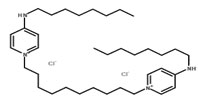Octenidine HCL or better referred to as Octenidine Dihydrochloride is a lively surfactant thats cationic in nature. Octenidine features a Gemini surfactant structure and is a derivative from pyridine. The finest part about Octenidine HCL is its active nature against gram-negative and gram-positive bacteria. Octenidine HCL or Octenidine Dihydrochloride is safe to handle, chemically stable and not inflammable. It is used for the treatment of wound infections and for disinfecting the skin and mucous membrane.
Since the year 1987, the compound has been utilized in the manufacturing of antiseptic and anti-bacterial products. It gained a lot of ground in terms of popularity, especially in all over Europe next to neonates.
It is an excellent substitute for Chlorhexidine, especially when used in a concentrated form of 0.1 to 2.0%. Another aspect of this compound that makes it all the more appealing to the mass production industry is its economic factor. In other words, Octenidine HCL preparations are cheap to manufacture, design and store.
In Controlled tests, especially suspension tests of in-vitro nature over a period of 5 minutes have shown that Octenidine HCL in small amounts is perfectly capable of killing disease-causing bacteria/microbial life like:
Back in 2014, a controlled study was carried out that consisted of 17 patients who were subjected to ICU units in different hospitals in Berlin. The compound was applied on the skins of each of these patients with the goal of observing whether the compound is capable of decreasing nosocomial infection rates.
Another survey carried out in the neonatal ICUs of leading German hospitals proved that when Octenidine HCL is administered to the patients, symptoms of skin conditions like blistering, scarring and necrosis watered down.
All in all, due to its many benefits as an antibacterial and antimicrobial compound, Octenidine HCL finds extensive use within the manufacturing sector related to cosmetics and personal care products.
Octenidine Dihydrochloride is a cationic surfactant, pyridine based molecule and is used extensively as an antiseptic for topical applications. It has been found in large area of application and is an alternative for older substances like Chlorhexidine, Polividone-iodine and Triclosan.
It is used for the topical application of Atopic Dermatitis, Wounds, Vaginal Applications, Inflated Eczema, Acne, and Herpes and for controlling multidrug resistant pathogens.
| Product Name | Octenidine Dihydrochloride |
| CAS No. | 70775-75-6 |
| EINECS No. | 274-861-8 |
| Chemical Name | N,N'-[Decane-1,10-diyldi-1(4H)-pyridyl-4-ylidene]bis(Octylammonium) Dichloride |
| Chemical Formula | C 36 H 64 C 12 N 4 |
| Molecular Weight | 623.83 |
| Synonyms | N-octyl-1-[10-(4-octyliminopyridin-1-yl)decyl]pyridin-4-imine dihydrochloride. N,N'-(decane-1,10-diyldipyridin-1-yl-4-ylidene)dioctan-1-amine dihydrochloride |
| Structure |  |
| Description | Parameter |
|---|---|
| Appearance | White to off white powder |
| Identification 1) Infrared Spectroscopy 2) HPLC |
Matches with the standard The retention time of the sample matches with the standard |
| Moisture | NMT 2.0% |
| Related Substances by HPLC 1) 4-Octyl Amino pyridine 2) Unknown individual impurity 3) Total impurities |
NMT 0.1% NMT 0.1% NMT 0.5% |
| Purity (on dry basis) | 98% - 100% |
0.1 - 2.0%
Store in a cool dry area. Protect it from extreme heat conditions.
2 years from the date of manufacturing.
25 kg HDPE bags or carton